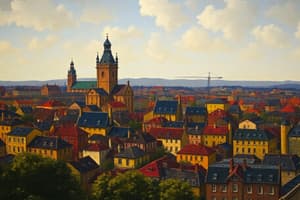Podcast
Questions and Answers
What is the primary reason for villages transforming into towns?
What is the primary reason for villages transforming into towns?
- Greater entertainment options
- Increased agricultural production
- Improved communication technology
- Desire for more local control and resources (correct)
Which of the following characteristics is NOT typical of a village?
Which of the following characteristics is NOT typical of a village?
- A small number of services
- Limited educational facilities
- Located in the countryside
- Population exceeding 3,000 people (correct)
What does urbanization refer to in the context of villages and cities?
What does urbanization refer to in the context of villages and cities?
- The process of population growth in rural areas
- The organization of community services
- The decline in rural populations
- The transition from villages to cities through development (correct)
Which service is likely to be available in a town but not in a village?
Which service is likely to be available in a town but not in a village?
What is the usual population of a city?
What is the usual population of a city?
Flashcards
What is a village?
What is a village?
A small cluster of houses, farms, and other buildings, typically in a rural area.
What is urbanization?
What is urbanization?
The process of a village growing into a town and then into a city, involving population increase, economic development, and infrastructure expansion.
What is a town?
What is a town?
A mid-sized settlement with a population between 1,000 and 100,000, offering more services and infrastructure than a village.
What is a city?
What is a city?
Signup and view all the flashcards
Why do people move to cities?
Why do people move to cities?
Signup and view all the flashcards
Study Notes
From Villages to Cities
- Early settlements formed near water sources and farms
- As populations grew, settlements expanded into villages, which are smaller groups of houses and farms.
- Villages were built in easily defensible locations, safe from flooding and enemies.
- Villages can transition to towns and then cities, in a process called urbanization
- Urbanization involves population growth, economic development, infrastructure expansion, and more access to resources
- Communities may seek town status to gain more local control and access to resources
Comparing Villages, Towns, and Cities
- Villages:
- Smallest settlement, typically with 100-3,000 people.
- Located in rural areas.
- Limited services; might have a post office, small shop, and sometimes a place of worship or doctor's office.
- Many people move to towns and cities.
- Towns:
- Mid-sized settlement, with 1,000-100,000 people.
- More services than villages, including primary/secondary schools, train stations, hospitals, shopping centers, and supermarkets.
- At least one place of worship.
- Cities:
- Large settlements, typically over 100,000 people.
- Wide variety of services like universities, sports stadiums, a large array of shops, restaurants, and places of worship.
- Many transport links and job opportunities.
- Many people move to cities for better employment prospects and leisure options.
Studying That Suits You
Use AI to generate personalized quizzes and flashcards to suit your learning preferences.




